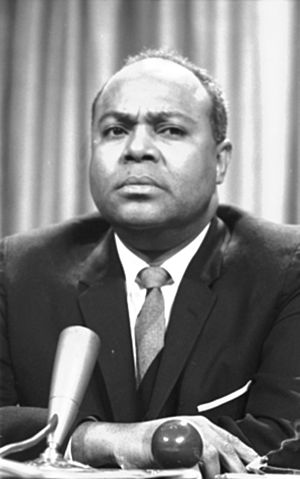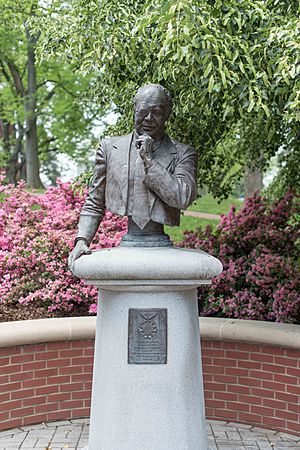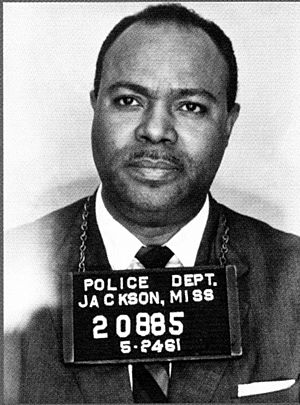James Farmer facts for kids
Quick facts for kids
James Farmer
|
|
|---|---|

Farmer in 1964
|
|
| 1st National Director of the Congress of Racial Equality | |
| In office 1942–1966 |
|
| Preceded by | Position established |
| Succeeded by | Floyd McKissick |
| Personal details | |
| Born |
James Leonard Farmer Jr.
January 12, 1920 Marshall, Texas, US |
| Died | July 9, 1999 (aged 79) Fredericksburg, Virginia, US |
| Political party | Republican |
| Spouses |
|
| Children | Abbey, Tami Lynn |
| Parent |
|
| Alma mater | Wiley College |
| Occupation | Civil rights activist |
James Leonard Farmer Jr. (born January 12, 1920 – died July 9, 1999) was an American civil rights leader. He believed in using nonviolence to fight against segregation. Segregation was the unfair practice of keeping people of different races separated.
Farmer worked alongside other important leaders like Martin Luther King Jr.. In 1961, he started and organized the first Freedom Ride. This important event helped end segregation on buses and trains that traveled between states in the United States.
In 1942, Farmer helped create the Committee of Racial Equality in Chicago. This group later became known as the Congress of Racial Equality (CORE). CORE worked to end racial segregation in the U.S. using peaceful methods. Farmer was the national chairman of CORE from 1942 to 1944.
By the 1960s, Farmer was known as one of the "Big Four" civil rights leaders. The others were Martin Luther King Jr., Roy Wilkins from the NAACP, and Whitney Young from the Urban League.
Contents
Biography
Early life and inspiration
James L. Farmer Jr. was born in Marshall, Texas. His parents, James L. Farmer Sr. and Pearl Houston, were both teachers. His father taught at Wiley College, a college mainly for black students. He was also a minister. His mother was a homemaker and a former teacher.
When James was about three or four years old, he had a powerful experience with segregation. He wanted a Coca-Cola while out with his mother. She told him he had to wait until they got home. He watched another boy, who was white, go into a store and buy a Coke. His mother explained that James, as a person of color, was not allowed in that store. This unfair moment was the first time Farmer truly understood segregation.
Another important moment happened when Farmer was 10. His uncle, aunt, and cousin visited from New York. They had trouble getting a sleeping room on the train for their trip back. Farmer went to the train station with his father. His father convinced the manager to give his uncle a room. Farmer was shocked to hear his father lie to get the room, especially since his father was a minister. His father explained that it was the only way to get the reservation. This experience made Farmer want to dedicate his life to ending segregation.
Farmer was very smart for his age. In 1934, at just 14 years old, he started college at Wiley College. His father taught there. James joined the debate team, and his English professor, Melvin B. Tolson, became a very important mentor to him.
Adult life and education
At 21, Farmer was invited to the White House to meet President Franklin D. Roosevelt. Eleanor Roosevelt signed the invitation. Before meeting the President, Mrs. Roosevelt spoke with the group. Farmer liked her right away, and they talked a lot.
When they met President Roosevelt, Mrs. Roosevelt stayed and listened. Farmer asked a tough question about Britain and France being called "champions of freedom." He pointed out their colonial rule in Africa. The President tried to avoid the question, but Mrs. Roosevelt insisted he answer. Even though the President didn't fully answer, Farmer felt good that he had asked the question.
Farmer earned his first college degree from Wiley College in 1938. He then got another degree from Howard University School of Religion in 1941. During World War II, Farmer was a conscientious objector. This meant he refused to fight in the war because of his beliefs.
He was inspired by Howard Thurman, a professor at Howard University. Farmer became interested in Gandhi's ideas of pacifism, which means believing in peace and opposing war or violence. Martin Luther King Jr. later also used many of Gandhi's ideas. Farmer started thinking about how to stop racism in America while working for the Fellowship of Reconciliation.
In the 1950s, Farmer worked as a national secretary for the Student League for Industrial Democracy (SLID). This group was for young people and later became Students for a Democratic Society.
Farmer married Winnie Christie in 1945, but they divorced a year later. A few years later, he married Lula A. Peterson. They were told not to have children because of Lula's health. However, they later had two daughters: Tami Lynn Farmer, born in 1959, and Abbey Farmer, born in 1962.
Founding CORE and early actions
James Farmer had an idea to fight racial inequality. He spoke with A. J. Muste, a leader at the Fellowship of Reconciliation (FOR). Muste liked the idea and asked Farmer to write it down. Farmer spent months making sure his plan was perfect.
FOR decided not to officially support Farmer's group, but they gave him permission to start it in Chicago. When Farmer returned to Chicago, he and others began setting up the organization. They first called it the Committee of Racial Equality. About a year later, the name changed to the Congress of Racial Equality (CORE).
In 1964, Farmer explained CORE's main ideas:
- It involved everyday people, not just experts.
- It was against segregation.
- It fought segregation using nonviolent direct action. This meant peaceful protests and actions.
CORE used these ideas to challenge unfair rules. For example, they protested at Jack Spratt, a diner in Chicago that would not serve black people. CORE members, both black and white, sat at tables. No one would eat until the black people were served. Other customers already there also joined in. The manager tried to make them sit in the basement or a back corner, but the group refused. Finally, the police were called, but they would not remove the CORE group. In the end, everyone was served. After this, Jack Spratt changed its policy.
CORE also challenged the White City Roller Skating Rink, which only allowed white people. White CORE members could enter, but black members were turned away with excuses. CORE sued the rink. Even though the judge ruled against CORE, the group was becoming known for its efforts.
The Freedom Rides
In 1961, Farmer became the national director of CORE again. The Civil Rights Movement was growing stronger. The U.S. Supreme Court had already said that segregated bus travel between states was illegal. But in Southern states, segregation was still enforced.
Farmer got an idea for a new "Freedom Ride." The group planned to travel through the Deep South to test these laws. Farmer named the trip the "Freedom Ride."
The plan was for a group of mixed races and genders to ride buses. They would train in Washington D.C. on nonviolent tactics. The ride began on May 4, 1961. Half the group rode on Greyhound buses, and the other half on Trailways buses. They planned to travel through Virginia, the Carolinas, Georgia, Alabama, and Mississippi, ending in New Orleans on May 17. They also planned to challenge segregated seating in bus stations and lunchrooms. Along the way, they would hold rallies and get support from local black communities.
The first part of the trip through Virginia, the Carolinas, and Georgia went smoothly. States knew about the ride, and many places removed "Colored" and "White Only" signs. Before the group reached Alabama, the most dangerous part of the ride, Farmer had to go home because his father passed away.
In Alabama, the other riders faced severe violence. They were beaten and attacked. One bus was even firebombed. With the bus destroyed, they flew to New Orleans instead of finishing the ride by bus.
Diane Nash and other students quickly gathered new college students to restart the Freedom Ride. Farmer rejoined the group in Montgomery, Alabama. The Riders again faced extreme violence. In Birmingham, the sheriff allowed members of the Ku Klux Klan to attack the Riders. A photographer was badly hurt. These violent events got a lot of attention from national news.
Their brave actions inspired many similar rides throughout the summer. Other civil rights leaders and thousands of ordinary people joined in. In Jackson, Mississippi, Farmer and other riders were immediately jailed. They followed a "jail no bail" strategy. This meant they stayed in jail to fill them up with protesters and get more media attention. From local jails, they were sent to harsher conditions at Parchman State Penitentiary.
As the Freedom Rides were attacked, news coverage became widespread. Photographs, newspaper stories, and movies showed what was happening. CORE, segregation, and civil rights became major national issues. Farmer became well known as a civil rights leader. The Freedom Rides even inspired the Freedom Writers Foundation.
The next year, civil rights groups worked with local activists in Mississippi. They helped people register to vote and learn about their rights. James Chaney, Andrew Goodman, and Michael Schwerner were three young men Farmer had helped recruit for CORE. They disappeared during the Mississippi Freedom Summer. An FBI investigation found their bodies buried in a dam. Their murders inspired the 1988 movie, Mississippi Burning. Farmer later said that everyone was scared during the civil rights movement. He admitted he was scared all the time.
Later career and legacy

In 1963, police in Louisiana searched for Farmer because he was organizing protests. A funeral home director helped Farmer escape by having him pretend to be dead in the back of a hearse. He was driven out of town on back roads. He was arrested later that August for disturbing the peace.
As the Director of CORE, Farmer was one of the "Big Six" leaders of the Civil Rights Movement. He helped organize the famous March on Washington for Jobs and Freedom in 1963.
Farmer resigned as director of CORE in 1966. He felt that some parts of CORE were becoming too militant. By this time, important laws had been passed. The Civil Rights Act of 1964 ended legal segregation. The Voting Rights Act of 1965 helped make sure everyone could vote.
Farmer then became a teacher at Lincoln University, a college for black students in Pennsylvania. He also gave speeches across the country. In 1968, Farmer ran for U.S. Congress but lost.
In 1969, President Richard Nixon offered Farmer a job in the government. Farmer became Assistant Secretary of the Department of Health, Education, and Welfare. However, he resigned the next year because he was frustrated with the government's slow processes.
Farmer retired from politics in 1971 but stayed active. He gave lectures and served on many boards. In 1973, he signed the Humanist Manifesto II. In 1975, he helped start the Fund for an Open Society. This group works for communities where people of different races and backgrounds live together peacefully. He led this organization until 1999.
Farmer was also an honorary vice chairman of the Democratic Socialists of America.
He wrote his autobiography, Lay Bare the Heart, in 1985. In 1984, Farmer began teaching at Mary Washington College (now The University of Mary Washington) in Fredericksburg, Virginia.
Farmer retired from teaching in 1998. He passed away on July 9, 1999, at age 79, due to complications from diabetes.
Legacy and honors
- A statue of Farmer was placed at the University of Mary Washington.
- In 1987, Mary Washington College started the James Farmer Scholars program. This program encourages minority students to attend college.
- In 1995, the city of Marshall, Texas, renamed Barney Street, where Farmer grew up, to James Farmer Street. This honored both him and his father.
- In 1998, President Bill Clinton gave Farmer the Presidential Medal of Freedom. This is one of the highest awards a civilian can receive in the U.S.
Freedom and equality are inherent rights in the United States: therefore, I encourage young people to take on the task by standing up and speaking out on behalf of people denied those rights. We have not yet finished the job of making our country whole
- In 2012, the Library of Virginia honored Farmer as one of its "Strong Men and Women" African American trailblazers.
- In 2020, the University of Mary Washington renamed Trinkle Hall to James Farmer Hall. This honored Dr. Farmer, who taught history there in his final years.
Works
- Lay Bare the Heart: An Autobiography of the Civil Rights Movement. James Farmer, Penguin-Plume, 1986 ISBN: 0-452-25803-0
- He wrote Religion and Racism, but it has not been published.
- Freedom-When was published in 1965.
In 1992, Fellowship magazine featured discussions by Farmer and George Houser about how CORE was founded. A conference in Ohio also explored CORE's beginnings. Both Houser and Farmer attended. Everyone agreed that the main founders of CORE were James Farmer, George Houser, and Bernice Fisher.
See also
 In Spanish: James Farmer para niños
In Spanish: James Farmer para niños
Further research
- Archival materials
- Videos
Images for kids





